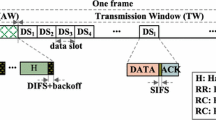Abstract
Ultra wide band (UWB) technology will be applied in the high rate wireless personal area networks (WPANs) for its high rate, low power, and innate immunity to multipath fading. In this paper, a power aware multi-hop packet relay MAC protocol in UWB based WPANs is proposed and a power aware path status factor (PAPSF), which is derived from SINR and power resource condition of each device, is used to select a suitable relay node. Compared with relaying by piconet coordinator (PNC), which is easily chosen by other ad hoc routing protocol, the new scheme can achieve higher throughput, decrease the time required for transmitting high power signal and we can easily distribute the battery power consumption from PNC to other devices in the piconet to prevent the PNC device using up its battery too fast and finally avoid PNC handover too frequently.
This research was supported by University IT Research Center Project (INHA UWB-ITRC), Korea.
Preview
Unable to display preview. Download preview PDF.
Similar content being viewed by others
References
Porcino, D., Hirt, W.: Ultra-wideband radio technology: Potential and challenges ahead. IEEE Communications Magazine 41(7), 66–74 (2003)
Horie, W., Sandara, Y.: Novel Packet Routing Scheme based on Location Information for UWB Ad-hoc Network. In: Proc. of IEEE Conference on Ultra Wideband Systems and Technologies, pp. 185–189 (2003)
Win, M.Z., Scholtz, R.A.: Ultra-Wide Bandwidth Time-Hopping Spread-Spectrum Impulse Radio for Wireless Multiple-Access Communications. IEEE Transactions on Communications 48, 679–689 (2001)
Balakrishnan, J., Batra, A., Dakak, A.: A multi-band OFDM system for UWB communication. In: IEEE Ultra Wideband Systems and Technologies Conference, pp. 354–358 (2003)
IEEE std. 802.15.3, Information technology - Telecommunications and information exchange between systems - Local and metropolitan area networks - Specific requirements - Part 15.3: Wireless Medium Access Control (MAC) and Physical Layer (PHY) Specifications for High Rate Wireless Personal Area Networks (WPANs) (2003)
Perkins, C.E., Royer, E.M.: Ad hoc on-demand distance vector routing. In: Proc. of IEEE Workshop on Mobile Computing Systems and Applications (1999)
Dube, R., Rais, C.D., Wang, K.Y., Tripathi, S.K.: Signal stability-based adaptive routing for ad hoc mobile networks. IEEE Personal Communications Magazine, 36–45 (1997)
Toh, C.K.: Maximum battery life routing to support Ubiquitous mobile computing in wireless ad hoc networks. IEEE Communications Magazine 39(6), 138–147 (2001)
Gyoda, K., Kado, Y., Ohno, Y., Hasuike, K., Ohira, T.: WACNet wireless ad-hoc community network. In: IEEE International Symposium, vol. 4, pp. 862–865 (2001)
IEEE P802.15 Working Group for WPANs, Multi-band OFDM Physical Layer Proposal for IEEE 802.15 Task Group 3a (2004)
The Network Simulator – ns2, http://www.isi.edu/nsnam/ns/
Author information
Authors and Affiliations
Editor information
Editors and Affiliations
Rights and permissions
Copyright information
© 2005 Springer-Verlag Berlin Heidelberg
About this paper
Cite this paper
Wang, W., Seo, CK., Yoo, SJ. (2005). Power Aware Multi-hop Packet Relay MAC Protocol in UWB Based WPANs. In: Jia, X., Wu, J., He, Y. (eds) Mobile Ad-hoc and Sensor Networks. MSN 2005. Lecture Notes in Computer Science, vol 3794. Springer, Berlin, Heidelberg. https://doi.org/10.1007/11599463_57
Download citation
DOI: https://doi.org/10.1007/11599463_57
Publisher Name: Springer, Berlin, Heidelberg
Print ISBN: 978-3-540-30856-0
Online ISBN: 978-3-540-32276-4
eBook Packages: Computer ScienceComputer Science (R0)




